Light budget, heavy thinking
(Tuned City, Berlin _i)
(( --> [ _o ] [ _one. ] [ _two. ] [ _three. ] [ _four. ] [ _five. ] [ _six. ] || [ found ] ))
october 29, 2008.
" in [...] a
sealed tuna sandwich
with
the wrapper glued "
( * )
Regular viewers may remember my trip, early february last year, when I
went back
to Berlin to be part of the then second edition of Rinus van Alebeek's
das kleine
[ field recordings festival ]. That was
between february 3rd and 12th, 2007. After that eventful week das kleine
geared up. There was a third edition, which went on for much of a month:
throughout all of august last year. Then Rinus must've thought, "oh
what the hell ...!" ... and he went into ∞-mode ...
Thus the fourth edition of the festival was announced to last for
all of the year 2008. I think it will continue, also beyond. For
with the ∞ das kleine shifted into an asymptotic
Zen-mode:
it is whenever it is except when it is not, for then it isn't ...
Like the steadily growing number of performing musicians and other artists
that, as Bobby
Dylan and Damo
Suzuki, set out on neverending tours, das kleine became
das kleine, neverending ...
With next to no-budget, quite a bit of stubbornness, lots of inventiveness, and an open ear, Rinus established - as it quite appropriately was described in this year's Tuned City-conference program booklet - one of Berlin's most uninstitutional institutions.
Rinus is a man of stories. He is very much aware that next to everyone that is passing through Berlin, from far or from near, will have a unique story to tell. And if you are ready and willing to share that story through sounds, you're welcome at das kleine. Whether as an artist you move in the high and academic circles, or whether you rather stay low and underground: if you agree to but (maybe) a couple of free beers and (sometimes) part of the door money, you're in. There is hardly another past or present event that I know of that is that open and accessible, to both artists and audience. As things go, up until now it is an accessibility that is foremost attracting the artists. Maybe that will change. Maybe not ... But where many a traveling artist, new to a city and with little contacts, will often find such a town to be like Zappa's Centerville ("a sealed tuna sandwich with the wrapper glued"), in Berlin there's Rinus and das kleine, to open up the wrapper for you ...
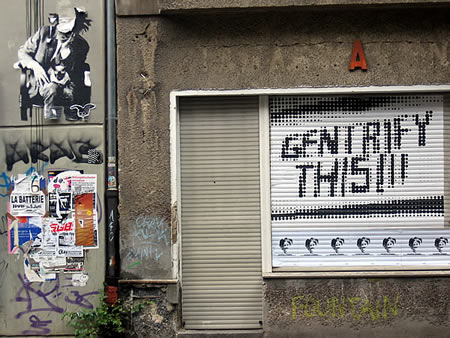
From the south eastern outskirts of town, das kleine and Rinus together slowly got sucked into the city, where earlier this year they settled - for the time being - in green 'n' upcoming Neukölln, as did and do a great many other seers, dreamers, drifters & hipsters. It was there, in the Weserstraße, that I joined him in the first week of this year's july, on the occasion of das kleine's contribution to Tuned City, an "exhibition and conference project" that took place between july 1st and 5th 2008, and which "proposed a new evaluation of architectural space from the perspective of the acoustic".
"Wherever you go, there you are ..."
Upon arrival at the Berlin Hauptbahnhof on the 30th of june 2008, I took
one of those double-sized city-style harmonica buses to Neukölln. It was
early in the evening but long past rush hour. The bus was pretty much empty
during most of the 9 km long ride, that was accompanied by an awful lot
of squeaking, rumbling, rambling and wind whistling. I sat down somewhere
in the middle of it all, with my luggage. As is my habit, there was
a dictaphone in my pocket, and it was recording. Onto an old cassette tape,
one of the many hundreds of tapes that FlexRex found with the garbage this
year in the streets of Montreuil, and for which I heartily thank him. Unless
what's on them is very special or peculiar (which mostly it isn't), I recycle
these tapes by using them to record.
One or two stops from the station, two old ladies (both will have been in their late seventies) got on the bus. They sat down just opposite to me. They busily giggled and chatted, their bags on their knees, meanwhile swaying and bumping along with the bus that continued to rush down southwards along Berlin avenues. One of them had a particularly sharp voice, with which she pointed out several buildings - most of them churches - to her friend, adding all sorts of remarks, anecdotes and stories about them. Obviously they were from Berlin, and they must have been living through much of the city's eventful recent history. The sound of their voices, thus embedded in the loud noises of the bus ride, struck me as a remarkably 'tuned' sonic welcome to Berlin ... It also reminded me of a very just observation by Rod Summers, who - asked in an interview what was 'the sound of Maastricht' - pointed to: "the sound of people talking to each other in Maastricht dialect". That, and the sound of the town hall bells.
Thus the two ladies babbling on about neighborhoods, churches, squares and palaces, and all that was there 'früher' ... to me this was 'the sound of Berlin'.
That, and maybe the sound of sirens.
But then there are no more sirens in Berlin ...
"If something happens we'll have to send out police loudspeaker cars," declared Michael Wiegand, one of those responsible for alerting the Berlin population in case of a terrorist attack or some other disaster, earlier this year. "There are no more sirens in Berlin ..." ( ** ) ...
It therefore probably was unavoidable that the Sirens exhibition at general public that was part of the Tuned City activities had to be something of a disappointment.
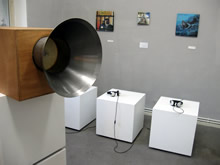 |
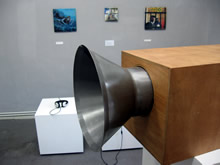 |
The small exhibition, curated by James Beckett, seemed to all but loose itself in a handful of random anecdotes and mere after-thoughts. Neither rigorously historico-scientific, nor unpretentiously pop, it had obviously not been made with Berlin in mind. It had been on in several other cities already, and coming to Berlin with - it seems - just ever so slight modifications, the show ('Sirens. An Evolution from Water, through Water, to Water') seemed sort of homeless, whereas it should have been rooted. That, I think, is a missed opportunity. Just imagine the themes and how they connect: Berlin, Sirens, Tuned City, Architectural Space, Acoustics ...
In turn this reminds me of Ryoji Ikeda's monumental spectra [paris] installation next to the Tour Montparnasse, commissioned by the city of Paris for this year's Nuit Blanche, during the first weekend of october. It was actually by accident that I stumbled upon Ryoji's installation (whose work, btw, I was/am hardly familiar with).
On friday evening october 4th I went to the opening of the "Cover
Record" exposition, at Immanence.
"Cover Record" had the gallery's wall covered with (mainly) covers of records
that in some way are sound/art - art/sound related. From the itialian futurist manifesto
on to today, passing along dada, fluxus, pop-art, sound poetry, conceptual art, happening,
musique concrète, 20th century avantgarde, electronic, experimental music, pop, rock, punk ...
An interesting collection to look at and contemplate, and most
certainly of educational interest (also because of the extensive and well-researched
liner notes) as well as worthwhile for collectors. It was though rather
haphazard, and obviously composed from that which - one way or another -
was or had been made available. Now I'm of an age that I actually would have been
able to buy most of the items on show at the time of their original release.
And quite a few of them I actually did buy back then, so that it did
look to me as if Frédéric and Cannelle had been nosing in my collection
and stuck large parts of it on the walls of their gallery ... ![]() ... ( *** )
... ( *** )
The Immanence gallery is just across from the Tour Montparnasse, and when I left the show to walk back to the Montparnasse station there were whiffs of pretty abstract electronic music floating over from behind the tower. So I became curious and headed in the direction from where the sounds came. It lead me to a most amazing light sculpture.
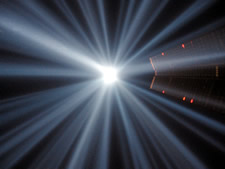 |
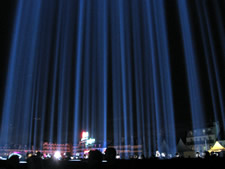 |
Using a square grid of 8 x 8 high intensity, narrow beam floodlights placed at 2 meter intervals apart at the foot of the north wall of the Montparnasse office building, Ikeda erected an immense cone of light, that was a second - and far bigger - tower. Overwhelming, really, breathing precision, power and grandeur. It was the parisian version of spectra, another version of which recently was installed in Amsterdam, on the occasion of Dream Amsterdam 2008. Ryoji continues to adapt his works to specific places and circumstances. Thus the sounds were a version of his matrix. Loudspeakers placed around (and maybe also within, I am not quite sure) the grid of floodlights broadcasted patterns of sine waves of varying frequencies, the perception of which changes because of your moving about, as well as because of the movements and actions of the (many) other people walking around.
Spectra/Matrix was convincing as a dramatic but accessible modification - a re-tuning - of public space; experiencing it a very social event, with hundreds of visitors wandering in amazement around and within the grid of sounds and lights.
But the more I looked up into the fixed and luminous point of the needle, the more I became convinced that the sinewave sounds were not the right sounds to accompany this monument. What I had wanted to hear - and what I clearly began to imagine hearing when I walked away from the tower - is a music based upon the sound of air-raid sirens ... Though of course Ryoji will not agree, it would have been even better. And on the tube back home I closed my eyes and imagined it thus at Berlin's Alexanderplatz ... It was near to perfect.
...
At some stop somewhere along the ride from Hauptbahnhof to Neukölln a young man stepped on the bus. He sat down behind me. The ladies babbled on, but I saw how the one with the sharp voice began eyeing the younger passenger, who quietly was sitting and looked out of the window. The lady could not keep her eyes of his blue jeans, the legs of which were torn just below the knees. Something about that was bothering her. It bothered her a lot. She pinched her eyes, and looked at her neighbor. Then quite suddenly she kept silent. For a while she didn't say a word, just sat there looking at the young man's blue jeans. Then she nudged her neighbor's shoulder and with a disapproving look said, loud enough to make sure that the young man and me would be able to clearly hear what it was that she had to say: "Wenn wir nach den Krieg sowas hätten anziehen müssen, dann hätten wir geheult, wären wir nicht auf die Strasse gegangen," she said. "Dann hätten wir geweint, dann wären wir nicht auf die Strasse gegangen wenn uns unsere Mutter sowas angezogen hätte ... Also schön ist das nicht ! ..." [ "After the war we would have cried if our mothers had sent us out into the street wearing trousers like that. We would have cried, and we would not have gone out into the street if our mothers hat dressed us like that ... It is not very pretty ! ..." ]
![]() Of course it all ended up on the old cassette that continued to eavesdrop
along, all the way. Due to the cassette's age and somehow somewhat stiff
mechanics, it ended up on there in a rather peculiar way, though. The recording
comes with a bad case of wow and flutter, that over time slowly creeps
in and then gradually is getting worse. It imposes itself as an additional layer
onto the recording. You can listen to the bus ride in "Jetzt erst, jetzt
... Neukölln", which is the first in the series of radio-dicta-phonic
sound reports that will audio-document my stay at Neukölln, Tuned City and
das kleine during the first week of this year's july. Together these reports
are going to constitute the 14th edition of Raudio, which will evolve into its final form over the next couple
of weeks or so.
Of course it all ended up on the old cassette that continued to eavesdrop
along, all the way. Due to the cassette's age and somehow somewhat stiff
mechanics, it ended up on there in a rather peculiar way, though. The recording
comes with a bad case of wow and flutter, that over time slowly creeps
in and then gradually is getting worse. It imposes itself as an additional layer
onto the recording. You can listen to the bus ride in "Jetzt erst, jetzt
... Neukölln", which is the first in the series of radio-dicta-phonic
sound reports that will audio-document my stay at Neukölln, Tuned City and
das kleine during the first week of this year's july. Together these reports
are going to constitute the 14th edition of Raudio, which will evolve into its final form over the next couple
of weeks or so.
I got off the bus in Neukölln, on the corner of Sonnenallee and Panierstraße, where Rinus was waiting for me.
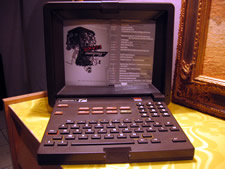 |
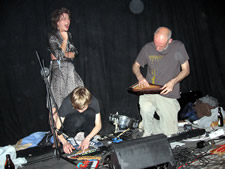 |
That evening we walked over to Kreuzberg, to Madame Claude's in the Lübbener Straße, where Rinus, Magnus and Mireia performed their Topmodel. There were other performances as well. One before and one after.
These I choose to forget.
- next: Cake & Coffee -
notes __ ::
(*) Words from the lyrics to "This town is a sealed
tuna sandwich", a tune from the very beginning of Frank Zappa's 200
Motels. [ ^ ]
(**) In: "Die
Rückkehr der Sirenen", heise online, 12.05.2008 [
^ ]
(***) "Cover Record" can be visited at Gallery
Immanence (21, avenue de Maine, Paris XV), on thursday, friday and saturday afternoons, until november 1st. [
^ ]
tags: Berlin, Neukölln, sirens, das kleine, Paris
# .279.
comments for Light budget, heavy thinking ::
|
Comments are disabled |
Read about Berlin on the SoundBlog:
(august 4, 2022) - Berlin: Zero Cohesion (3)
(july 24, 2022) - Berlin: Zero Cohesion (2 = ©)
(july 11, 2022) - Berlin: Zero Cohesion (1)
(november 11, 2021) - A Berlin Reader
(august 05, 2011) - (I can't get no) Immediate Satisfaction (Diktat in Berlin_iii)
(july 31, 2011) - 'Kommt raussi!' (Diktat in Berlin_ii)
(july 29, 2011) - 'Where ist Ausland?' (Diktat in Berlin_i)
(february 07, 2009) - « Mok mok jaha für das kleine in Berlin (Tuned City, Berlin_vi)
(december 23, 2008) - « das kleine, Intiem » (Tuned City, Berlin_v)
(december 08, 2008) - un-Tuned City (foundtaping in Neukölln) (Tuned City, Berlin_iv)
(november 12, 2008) - Neurosen der Präzision (Tuned City, Berlin_iii)
(november 07, 2008) - Cake & Coffee (Tuned City, Berlin_ii)
(october 29, 2008) - Light budget, heavy thinking (Tuned City, Berlin_i)
(october 12, 2008) - Hanna's Sirens (Tuned City, Berlin_o)
(july 01, 2007) - dinges (Back to Berlin, iii_3)
(april 25, 2007) - Fluxissage
(april 12, 2007) - reek or (Back to Berlin, iii_2)
(april 08, 2007) - i feelt (Back to Berlin, iii_1)
(march 07, 2007) - found tapes (Back to Berlin, ii)
(february 27, 2007) - "Bo tuny te..." (Back to Berlin, i)